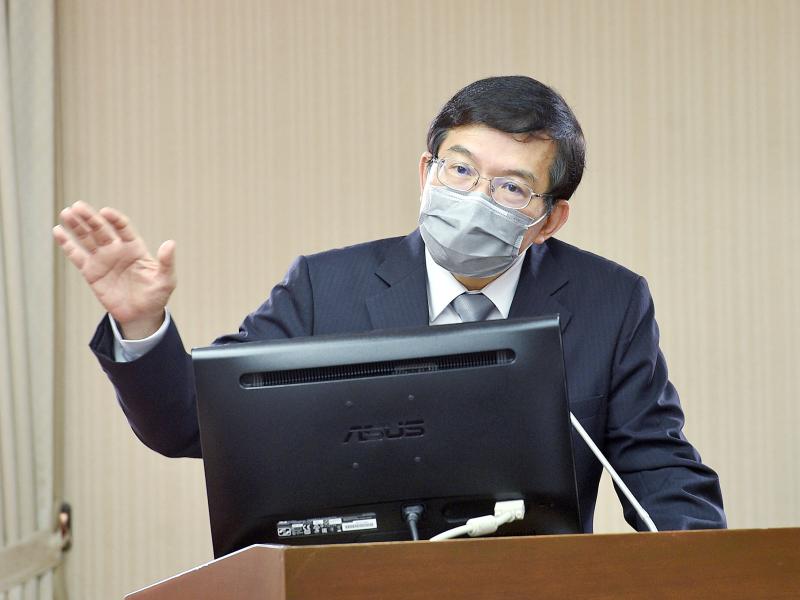Electric vehicle (EV) drivers would eventually have to pay fuel charges, Minister of Transportation and Communications Wang Kwo-tsai (王國材) said yesterday.
Wang made the remark at a meeting of the legislature’s transportation committee in response to questions about how the ministry would make up for an eventual shortfall in revenue as more drivers switch to electric vehicles.
The government collects about NT$53 billion (US$1.78 billion) in fuel charge revenue per year, which funds road maintenance projects, Democratic Progressive Party (DPP) Legislator Lee Kun-tse (李昆澤) said.

Photo: Peter Lo, Taipei Times
While the current system, which levies fuel charge by vehicle types and engine sizes, charge ensures a reliable source of revenue and helps encourage drivers to switch to electric vehicles as the government targets net-zero carbon emissions by 2050, it is often criticized as unfair, as it does not account for vehicle usage, Lee said.
The revenue would inevitably fall short as the number of electric vehicles continues to increase, as those drivers are currently exempt from the charges, he said.
“In the 1960s, when the government at one point collected the fuel charge from drivers when they paid for gasoline at the pumps, it was discovered that only 65 percent of the estimated revenue was collected. The scheme led to unstable funding for road maintenance and created an additional financial burden for drivers if there was a surge in oil prices,” he said, adding that the government switched to the current system as a result.
The government considered levying fuel charges based on the distance traveled by drivers, but odometers can be tampered with to roll back mileage, he said.
Only about half of the nation’s motor vehicles are equipped with on-board diagnostics, which can be used to verify the mileage on odometers, he said.
Some have suggested that on-board equipment be installed to record vehicle usage, but drivers must spend additional funds to purchase such equipment, he added.
The government should learn from Japan, which has multiple ways to collect vehicle fuel charges, Lee said.
While the number of motor vehicles in Taiwan has grown from 8.19 million in 2020 to 8.33 million last year, revenue from vehicle fuel charges fell to NT$53.64 million last year from NT$53.76 million in 2020.
Sales of electric vehicles increased ninefold over the past five years, DPP Legislator Lin Chun-hsien (林俊憲) said, adding that the ministry would have to change the way it collects the charge.
“The fuel charge revenue that the ministry has collected over the past five years has surpassed the amount stated in the ministry’s budget by about NT$5 billion each year, which went straight to the national treasury. None of the surplus was used for road maintenance,” Lin said, adding that the ministry should prepare a budget based on the amount it actually collects.
Wang told lawmakers that the system should remain unchanged to prevent a funding shortfall for road maintenance projects in the short term.
The fuel charge and carbon fee should be separate pricing schemes: The former helps maintain roads, while the latter is designed to curb air pollution.
“Electric vehicle owners are exempt from paying fuel charges because the government is encouraging the use of electric vehicles. Should the number of electric vehicles continue to grow, owners would have to pay fuel charges for using roads,” Wang said.

Former president Ma Ying-jeou’s (馬英九) mention of Taiwan’s official name during a meeting with Chinese President Xi Jinping (習近平) on Wednesday was likely a deliberate political play, academics said. “As I see it, it was intentional,” National Chengchi University Graduate Institute of East Asian Studies professor Wang Hsin-hsien (王信賢) said of Ma’s initial use of the “Republic of China” (ROC) to refer to the wider concept of “the Chinese nation.” Ma quickly corrected himself, and his office later described his use of the two similar-sounding yet politically distinct terms as “purely a gaffe.” Given Ma was reading from a script, the supposed slipup

Former Czech Republic-based Taiwanese researcher Cheng Yu-chin (鄭宇欽) has been sentenced to seven years in prison on espionage-related charges, China’s Ministry of State Security announced yesterday. China said Cheng was a spy for Taiwan who “masqueraded as a professor” and that he was previously an assistant to former Cabinet secretary-general Cho Jung-tai (卓榮泰). President-elect William Lai (賴清德) on Wednesday last week announced Cho would be his premier when Lai is inaugurated next month. Today is China’s “National Security Education Day.” The Chinese ministry yesterday released a video online showing arrests over the past 10 years of people alleged to be

THE HAWAII FACTOR: While a 1965 opinion said an attack on Hawaii would not trigger Article 5, the text of the treaty suggests the state is covered, the report says NATO could be drawn into a conflict in the Taiwan Strait if Chinese forces attacked the US mainland or Hawaii, a NATO Defense College report published on Monday says. The report, written by James Lee, an assistant research fellow at Academia Sinica’s Institute of European and American Studies, states that under certain conditions a Taiwan contingency could trigger Article 5 of NATO, under which an attack against any member of the alliance is considered an attack against all members, necessitating a response. Article 6 of the North Atlantic Treaty specifies that an armed attack in the territory of any member in Europe,

The bodies of two individuals were recovered and three additional bodies were discovered on the Shakadang Trail (砂卡礑) in Taroko National Park, eight days after the devastating earthquake in Hualien County, search-and-rescue personnel said. The rescuers reported that they retrieved the bodies of a man and a girl, suspected to be the father and daughter from the Yu (游) family, 500m from the entrance of the trail on Wednesday. The rescue team added that despite the discovery of the two bodies on Friday last week, they had been unable to retrieve them until Wednesday due to the heavy equipment needed to lift